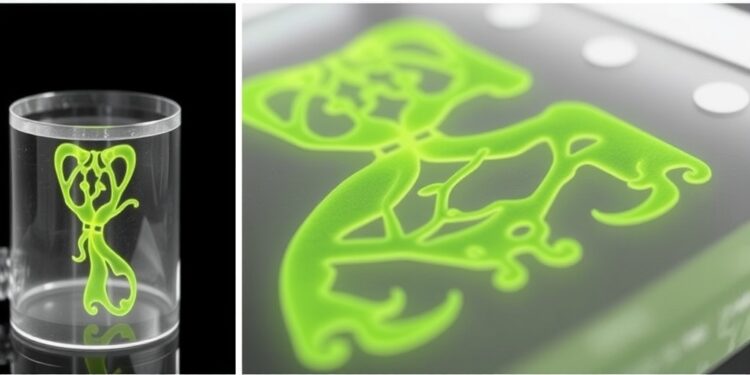The pursuit of recreating the complex architectures found in natural biological tissues has long captivated researchers in the realm of 3D bioprinting. Among the various technologies available for 3D printing, projection-based 3D printing stands out for its ability to deliver a superior Resolution/Time for Manufacturing ratio. This method, which has emerged as a cornerstone in bioprinting, presents remarkable potential for advancing the field of tissue engineering.
In a groundbreaking study led by a team from Zhejiang University, researchers unveiled a cutting-edge system dedicated to multi-material projection-based bioprinting (PBBP). This innovative approach incorporates a cleaning technique described as “fluid-controlled rinsing with negative pressure-assisted capillary adsorption.” The team engaged in a thorough exploration of the printability of various multi-material composites, which culminated in the creation of high-resolution composite bioink structures, noted for their fidelity and precision.
Yong He, the head of the research team, expressed his concerns regarding the historically uncharted territory of multi-material printing in bioprinting. “Due to the absence of systematic investigations and mature printing systems,” he articulated, “critical scientific and engineering challenges persist.” These challenges include notable inconsistencies in the photopolymerization characteristics inherent to multi-component bioinks, as well as issues related to material compatibility and the ever-present threat of contamination.
This research marks a significant milestone in the bioprinting landscape, as it was published in the journal “Research” on January 31, 2025. This journal represents the inaugural Science Partner Journal established in collaboration between the American Association for the Advancement of Science (AAAS) and the China Association for Science and Technology (CAST). Prof. He, who is a distinguished figure in the field of mechanical engineering, highlighted the necessity for standardized protocols in bioprinting technologies. “As bioprinting technologies advance,” he stressed, “multi-material printing represents an inevitable trajectory for field development.”
Central to this study is a foundational PBBP framework, which is designed with a unique vat-switching mechanism capable of synchronously printing up to six different materials. The integration of advanced operational software, alongside dedicated mechanical monitoring and visualization modules, ensures that this system operates with remarkable stability and efficiency. Furthermore, the inclusion of laser calibration technologies is indicative of an effort to enhance precision across all levels of the printing process.
Prof. He elucidates the importance of mimicking the various composite structures found within the human body, such as the junctions between bone and cartilage or the interfaces between skin and muscle. This necessitates the use of biocompatible inks that possess differing stiffness levels to accurately replicate these diverse tissues. However, the challenge arises when materials exhibit stark differences in mechanical properties, risking the potential for mismatches or inadequate bonding at the interfaces between distinct materials.
A significant contribution of this research is the establishment of a hydrogel bonding “rulebook.” This framework is grounded in the analysis of fracture energy, which measures the energy required to separate soft and hard hydrogels once combined. By determining the printable window for various material combinations, the research provides crucial guidelines for future bioprinting applications. The experimental results reveal how the patterns at the microscopic interfaces influence the range of compatible material combinations, ultimately broadening the scope of what can be achieved in bioprinting.
Contamination also looms large as a challenge in the realm of multi-material printing. Prof. He identifies two primary forms of contamination: infiltration and residual contamination. To tackle these issues, the research team has introduced standardized testing protocols aimed at assessing the penetration of viscous bioinks. By systematically investigating the factors governing infiltration rates, the researchers optimized the parameters for fluid flushing and the negative pressure-assisted capillary adsorption method, thereby significantly mitigating contamination risks.
In an additional effort to bolster the credibility of this new bioprinting technology, the team developed a resolution testing model. This model serves as a valuable tool for systematically evaluating printing accuracy. By identifying and isolating sources of error through comprehensive testing, the framework contributes significantly to the reproducibility and reliability of multi-material bioprinting processes. Understanding and enhancing resolution capabilities remains critical for the advancement of this technology.
As the field of bioprinting is continuously evolving, and multi-material printing emerges as a key player in this progression, the established findings provide substantial groundwork for future innovations. Establishing universally applicable evaluation frameworks and process standards is not merely beneficial but vital. Prof. He insists that achieving these goals is essential for fostering widespread adoption of advanced bioprinting systems, paving the way for breakthroughs in regenerative medicine and transplant therapies.
Moreover, this pivotal research opens the door for novel applications in 3D bioprinting, particularly in areas involving complex tissue interfaces. The implications of this work extend beyond academic interest, with practical applications poised to impact the future of medical science and surgical practices. As researchers continue to decode the complexities of human biology through advanced bioprinting technologies, the perspective of developing custom, anatomically accurate tissues becomes increasingly attainable.
These outcomes signify a substantial leap toward not only creating tissue constructs with high fidelity but also addressing the varied challenges posed by multi-material bioinks. The research contributions outlined herein serve as a strong foundation for future explorations in the bioprinting landscape and highlight the collaborative efforts necessary to overcome existing limitations.
By bridging the initial gaps in multi-material bioprinting, researchers urge the establishment of clear guidelines and methodologies to enhance the fields of bioprinting and tissue engineering. The convergence of engineering principles with biological sciences heralds a new horizon, wherein the intricate quilt of human tissue can one day be replicated with precision and efficacy, reshaping the landscape of regenerative medicine for generations to come.
Subject of Research: Multi-material Projection-Based 3D Bioprinting
Article Title: Printability in Multi-material Projection-Based 3-Dimensional Bioprinting
News Publication Date: March 4, 2025
Web References: http://dx.doi.org/10.34133/research.0613
References: [To be filled out as needed]
Image Credits: [To be filled out as needed]
Keywords: 3D bioprinting, multi-material printing, bioink, tissue engineering, photopolymerization, hydrogel, contamination, resolution testing, Zhejiang University.




